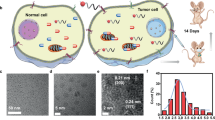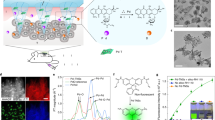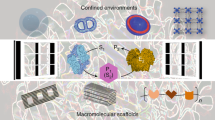Abstract
Bioorthogonal catalysis broadens the functional possibilities of intracellular chemistry. Effective delivery and regulation of synthetic catalytic systems in cells are challenging due to the complex intracellular environment and catalyst instability. Here, we report the fabrication of protein-sized bioorthogonal nanozymes through the encapsulation of hydrophobic transition metal catalysts into the monolayer of water-soluble gold nanoparticles. The activity of these catalysts can be reversibly controlled by binding a supramolecular cucurbit[7]uril ‘gate-keeper’ onto the monolayer surface, providing a biomimetic control mechanism that mimics the allosteric regulation of enzymes. The potential of this gated nanozyme for use in imaging and therapeutic applications was demonstrated through triggered cleavage of allylcarbamates for pro-fluorophore activation and propargyl groups for prodrug activation inside living cells.
This is a preview of subscription content, access via your institution
Access options
Subscribe to this journal
Receive 12 print issues and online access
$259.00 per year
only $21.58 per issue
Buy this article
- Purchase on Springer Link
- Instant access to full article PDF
Prices may be subject to local taxes which are calculated during checkout





Similar content being viewed by others
References
Patterson, D. M., Nazarova, L. A. & Prescher, J. A. Finding the right (bioorthogonal) chemistry. ACS Chem. Biol. 9, 592–605 (2014).
Ramil, C. P. & Lin, Q. Bioorthogonal chemistry: strategies and recent developments. Chem. Commun. 49, 11007–11022 (2013).
Bertozzi, C. R. A decade of bioorthogonal chemistry. Acc. Chem. Res. 44, 651–653 (2011).
Koo, H. et al. Bioorthogonal copper-free click chemistry in vivo for tumor-targeted delivery of nanoparticles. Angew. Chem. Int. Ed. 51, 11836–11840 (2012).
Devaraj, N. K., Thurber, G. M., Keliher, E. J., Marinelli, B. & Weissleder, R. Reactive polymer enables efficient in vivo bioorthogonal chemistry. Proc. Natl Acad. Sci. USA 109, 4762–4767 (2012).
Komatsu, H., Shindo, Y., Oka, K., Hill, J. P. & Ariga, K. Ubiquinone-Rhodol (UQ-Rh) for fluorescence imaging of NAD(P)H through intracellular activation. Angew. Chem. Int. Ed. 53, 3993–3995 (2014).
Sletten, E. M. & Bertozzi, C. R. From mechanism to mouse: a tale of two bioorthogonal reactions. Acc. Chem. Res. 44, 666–676 (2011).
Saxon, E. & Bertozzi, C. R. Cell surface engineering by a modified Staudinger reaction. Science 287, 2007–2010 (2000).
Li, J. & Chen, P. R. Palladium-triggered deprotection chemistry for protein activation in living cells. Nature Chem. 6, 352–361 (2014).
Sasmal, P. K., Streu, C. N. & Meggers, E. Metal complex catalysis in living biological systems. Chem. Commun. 49, 1581–1587 (2013).
Unciti-Broceta, A., Johansson, E. M. V., Yusop, R. M., Sánchez-Martín, R. M. & Bradley, M. Synthesis of polystyrene microspheres and functionalization with Pd(0) nanoparticles to perform bioorthogonal organometallic chemistry in living cells. Nature Protoc. 7, 1207–1218 (2012).
Streu, C. & Meggers, E. Ruthenium-induced allylcarbamate cleavage in living cells. Angew. Chem. Int. Ed. 45, 5645–5648 (2006).
Yusop, R. M., Unciti-Broceta, A., Johansson, E. M. V., Sánchez-Martín, R. M. & Bradley, M. Palladium-mediated intracellular chemistry. Nature Chem. 3, 239–243 (2011).
Sasmal, P. K. et al. Catalytic azide reduction in biological environments. ChemBioChem. 13, 1116–1120 (2012).
Do, J. H., Kim, H. N., Yoon, J., Kim, J. S. & Kim, H-J. A rationally designed fluorescence turn-on probe for the gold(III) ion. Org. Lett. 12, 932–934 (2010).
Weiss, J. T. et al. Extracellular palladium-catalysed dealkylation of 5-fluoro-1-propargyl-uracil as a bioorthogonally activated prodrug approach. Nature Commun. 5, 3277 (2014).
Yoon, H. J., Kuwabara, J., Kim, J-H. & Mirkin, C. A. Allosteric supramolecular triple-layer catalysts. Science 330, 66–69 (2010).
De, M., Ghosh, P. S. & Rotello, V. M. Applications of nanoparticles in biology. Adv. Mater. 20, 4225–4241 (2008).
Murphy, C. J. et al. Gold nanoparticles in biology: beyond toxicity to cellular imaging. Acc. Chem. Res. 41, 1721–1730 (2008).
Boisselier, E. & Astruc, D. Gold nanoparticles in nanomedicine: preparations, imaging, diagnostics, therapies and toxicity. Chem. Soc. Rev. 38, 1759–1782 (2009).
Tonga, G. Y., Saha, K. & Rotello, V. M. Interfacing nanoparticles and biology new strategies for biomedicine. Adv. Mater. 26, 359–370 (2014).
Mout, R. & Rotello, V. M. Bio and nano working together: engineering the protein–nanoparticle interface. Isr. J. Chem. 53, 521–529 (2013).
Kim, B. et al. Tuning payload delivery in tumour cylindroids using gold nanoparticles. Nature Nanotech. 5, 465–472 (2010).
Ghosh, P. et al. Intracellular delivery of a membrane-impermeable enzyme in active form using functionalized gold nanoparticles. J. Am. Chem. Soc. 132, 2642–2645 (2010).
Kim, C. K. et al. Entrapment of hydrophobic drugs in nanoparticle monolayers with efficient release into cancer cells. J. Am. Chem. Soc. 131, 1360–1361 (2009).
Manea, F., Houillon, F. B., Pasquato, L. & Scrimin, P. Nanozymes: gold-nanoparticles-based transphosphorylation catalysts. Angew. Chem. Int. Ed. 43, 6165–6169 (2004).
Wang, Z. et al. Nanoparticle-based artificial RNA silencing machinery for antiviral therapy. Proc. Natl Acad. Sci. USA 109, 12387–12392 (2012).
Pengo, P., Baltzer, L., Pasquato, L. & Scrimin, P. Substrate modulation of the activity of an artificial nanoesterase made of peptide-functionalized gold nanoparticles. Angew. Chem. Int. Ed. 46, 400–404 (2007).
Wei, H. & Wang, E. Nanomaterials with enzyme-like characteristics (nanozymes): next-generation artificial enzymes. Chem. Soc. Rev. 42, 6060–6093 (2013).
Natalio, F. et al. Vanadium pentoxide nanoparticles mimic vanadium haloperoxidases and thwart biofilm formation. Nature Nanotech. 7, 530–535 (2012).
Hastings, C. J., Backlund, M. P., Bergman, R. G. & Raymond, K. N. Enzyme-like control of carbocation deprotonation regioselectivity in supramolecular catalysis of the Nazarov cyclization. Angew. Chem. Int. Ed. 50, 10570–10573 (2011).
Ghosh, S. & Isaacs, L. Biological catalysis regulated by cucurbit[7]uril molecular containers. J. Am. Chem. Soc. 132, 4445–4454 (2010).
Masson, E., Ling, X., Joseph, R., Kyeremeh-Mensah, L. & Lu, X. Cucurbituril chemistry: a tale of supramolecular success. RSC Adv. 2, 1213–1247 (2012).
Lee, J. W., Samal, S., Selvapalam, N., Kim, H-J. & Kim, K. Cucurbituril homologues and derivatives: new opportunities in supramolecular chemistry. Acc. Chem. Res. 36, 621–630 (2003).
Kim, K. et al. Functionalized cucurbiturils and their applications. Chem. Soc. Rev. 36, 267–279 (2007).
Ambrogio, M. W., Thomas, C. R., Zhao, Y-L., Zink, J. I. & Stoddart, J. F. Mechanized silica nanoparticles: a new frontier in theranostic nanomedicine. Acc. Chem. Res. 44, 903–913 (2011).
Kim, H. et al. Glutathione-induced intracellular release of guests from mesoporous silica nanocontainers with cyclodextrin gatekeepers. Adv. Mater. 22, 4280–4283 (2010).
Liu, S. et al. The cucurbit[n]uril family: prime components for self-sorting systems. J. Am. Chem. Soc. 127, 15959–15967 (2005).
Khashab, N. M. et al. pH-responsive mechanised nanoparticles gated by semirotaxanes. Chem. Commun. 5371–5373 (2009).
Hong, R. et al. Control of protein structure and function through surface recognition by tailored nanoparticle scaffolds. J. Am. Chem. Soc. 126, 739–743 (2004).
Kim, C., Agasti, S. S., Zhu, Z., Isaacs, L. & Rotello, V. M. Recognition-mediated activation of therapeutic gold nanoparticles inside living cells. Nature Chem. 2, 962–966 (2010).
Angelos, S. et al. pH clock-operated mechanized nanoparticles. J. Am. Chem. Soc. 131, 12912–12914 (2009).
Alcaide, B., Almendros, P. & Alonso, J. M. A practical ruthenium-catalyzed cleavage of the allyl protecting group in amides, lactams, imides, and congeners. Chem. Eur. J. 12, 2874–2879 (2006).
Sasmal, P. K., Carregal-Romero, S., Parak, W. J. & Meggers, E. Light-triggered ruthenium-catalyzed allylcarbamate cleavage in biological environments. Organometallics 31, 5968–5970 (2012).
Zhu, Z-J. et al. Determination of the intracellular stability of gold nanoparticle monolayers using mass spectrometry. Anal. Chem. 84, 4321–4326 (2012).
Jeon, W. S. et al. Complexation of ferrocene derivatives by the cucurbit[7]uril host: a comparative study of the cucurbituril and cyclodextrin host families. J. Am. Chem. Soc. 127, 12984–12989 (2005).
Lineweaver, H. & Burk, D. The determination of enzyme dissociation constants. J. Am. Chem. Soc. 56, 658–666 (1934).
Miller, D. J., Surfraz, M. B-U., Akhtar, M., Gani, D. & Allemann, R. K. Removal of the phosphate group in mechanism-based inhibitors of inositol monophosphatase leads to unusual inhibitory activity. Org. Biomol. Chem. 2, 671–688 (2004).
Verma, A. et al. Surface-structure-regulated cell-membrane penetration by monolayer-protected nanoparticles. Nature Mater. 7, 588–595 (2008).
Gu, Z., Biswas, A., Zhao, M. & Tang, Y. Tailoring nanocarriers for intracellular protein delivery. Chem. Soc. Rev. 40, 3638–3655 (2011).
Cai, S. X. et al. Design and synthesis of rhodamine 110 derivative and caspase-3 substrate for enzyme and cell-based fluorescent assay. Bioorg. Med. Chem. Lett. 11, 39–42 (2001).
Saif, M. W., Choma, A., Salamone, S. J. & Chu, E. Pharmacokinetically guided dose adjustment of 5-fluorouracil: a rational approach to improving therapeutic outcomes. J. Natl Cancer Inst. 101, 1543–1552 (2009).
Longley, D. B., Harkin, D. P. & Johnston, P. G. 5-Fluorouracil: mechanisms of action and clinical strategies. Nature Rev. 3, 330–338 (2003).
Wang, Z. J., Clary, K. N., Bergman, R. G., Raymond, K. N. & Toste, F. D. A supramolecular approach to combining enzymatic and transition metal catalysis. Nature Chem. 5, 100–103 (2013).
Marr, A. C. & Liu, S. Combining bio- and chemo-catalysis: from enzymes to cells, from petroleum to biomass. Trends Biotechnol. 29, 199–204 (2011).
Acknowledgements
This work was supported by a grant from the National Institutes of Health (EB014277). T.M. acknowledges the Japan Society for the Promotion of Sciences for a Postdoctoral Fellowship for Research Abroad and for the Strategic Young Researcher Overseas Visits Program for Accelerating Brain Circulation. The authors thank L. Isaacs (University of Maryland) for providing cucurbit[7]uril.
Author information
Authors and Affiliations
Contributions
G.Y.T., Y.J. and V.M.R. conceived and designed the experiments. G.Y.T., Y.J., B.D., T.M., R.M., R.D., S.T.K., Y-C.Y., B.Y. and S.H. performed the experiments. All authors analysed and discussed the data. G.Y.T., Y.J., B.D. and V.M.R. co-wrote the paper. V.M.R. revised the paper. G.Y.T. and Y.J. contributed equally to this work.
Corresponding author
Ethics declarations
Competing interests
The authors declare no competing financial interests.
Supplementary information
Supplementary information
Supplementary information (PDF 3630 kb)
Rights and permissions
About this article
Cite this article
Tonga, G., Jeong, Y., Duncan, B. et al. Supramolecular regulation of bioorthogonal catalysis in cells using nanoparticle-embedded transition metal catalysts. Nature Chem 7, 597–603 (2015). https://doi.org/10.1038/nchem.2284
Received:
Accepted:
Published:
Issue Date:
DOI: https://doi.org/10.1038/nchem.2284
This article is cited by
-
Dipeptide coacervates as artificial membraneless organelles for bioorthogonal catalysis
Nature Communications (2024)
-
Metal complex catalysts broaden bioorthogonal reactions
Science China Chemistry (2024)
-
Biomimetic and bioorthogonal nanozymes for biomedical applications
Nano Convergence (2023)
-
Molecular insights of nanozymes from design to catalytic mechanism
Science China Chemistry (2023)
-
Soliton-Based Signaling Communication and Supermolecular Nano-complex by DDMC/PTX in Tumor Microenvironment
BioNanoScience (2023)



